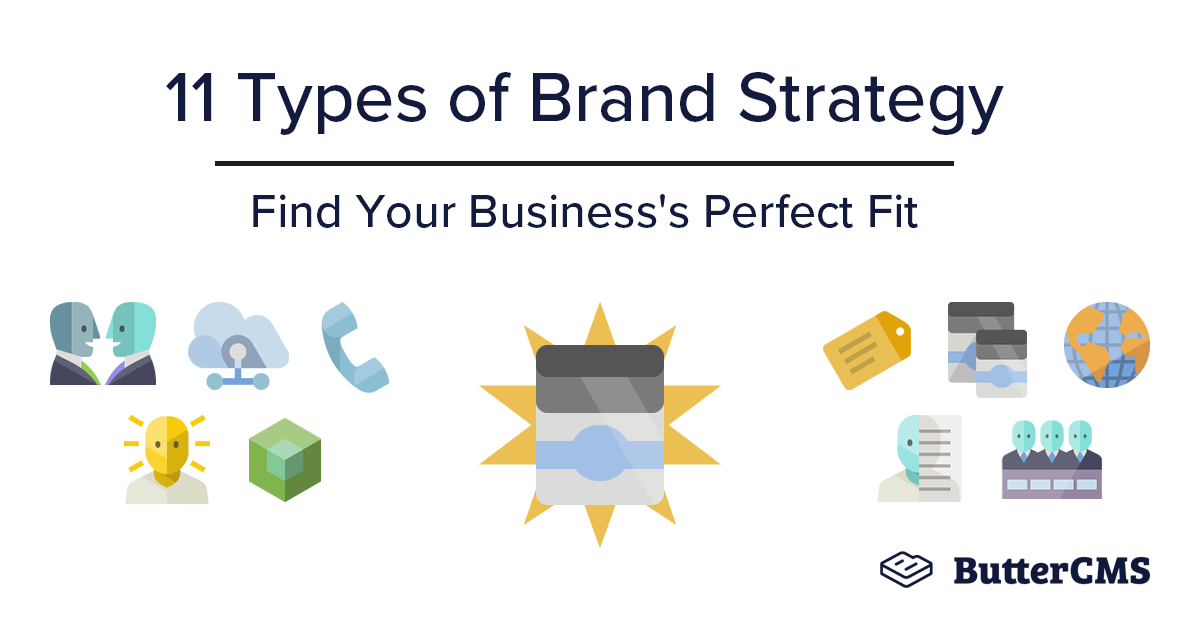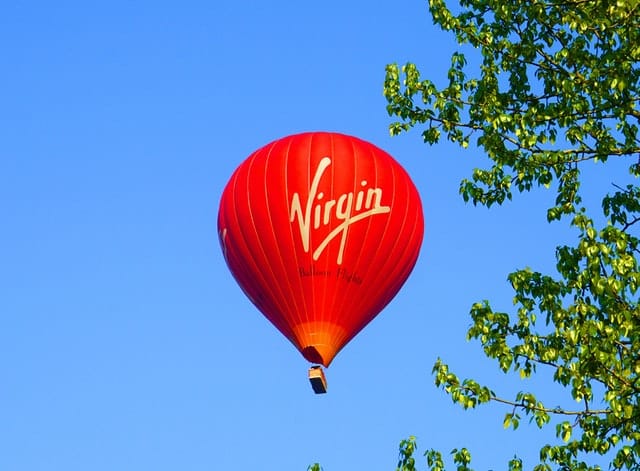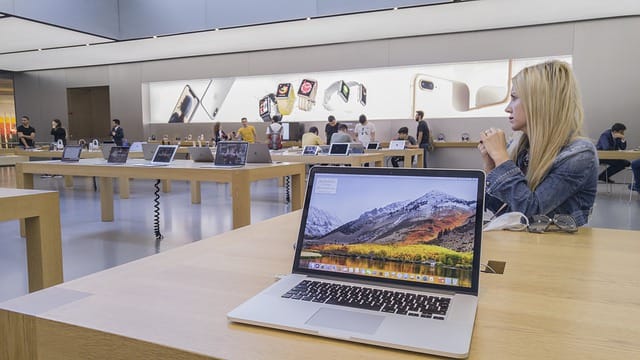- 11 Types of Brand Strategy
- Personal Branding
- Product Branding
- Corporate Branding
- Service Branding
- Co-Branding
- Online Branding
- No-Brand Branding
- Geographic Branding
- Retail Branding
- Cultural Branding
- Offline Branding
- How To Select the Best Brand Strategy for Your Business
- Best Practices for Building Your Brand
- Conclusion

GSD
11 Types of Brand Strategy: Find Your Business's Perfect Fit
Posted by Kesar Rana on October 13, 2023
This article will provide an overview of several popular types of brand strategy. It will also describe why an effective brand strategy is essential for your company and discuss some best practices for choosing one for your brand.
Branding is much more than choosing the right colors, setting up your website, and managing your social media pages. It involves adopting a strategic approach that educates your target audience.
Different types of strategies work for different types of businesses. With so many branding strategies to choose from, it can be challenging to find a good match for your brand. The best way to start identifying the right brand strategy is to define your brand identity. If you've done that, then one of the following types of brand strategy will probably jump off the page at you. Let's take a closer look.
Table of contents
11 Types of Brand Strategy
Personal Branding
Personal branding concepts are often connected with celebrities and public figures like social media influencers, movie stars, politicians, and athletes. This strategy is often connected with fame and popularity. The popularity aspect is a success driver for many successful entrepreneurs. Having a strong social profile that generates leads and builds a fanbase helps some businesses to gain traction.
Entrepreneur Richard Branson provides one of the best examples. Branson has done a lot of hard work to build a noticeable brand - fun, disruptive, adventurous, philanthropic, and globally recognizable. His branding covers all of his companies, which exist together under the Virgin brand.

Another excellent example of personal branding is SpaceX Founder and Tesla CEO Elon Musk. He has millions of adoring fans who will purchase any product he promotes. Because of his strong personal branding, Elon Musk was able to raise $1 million by selling branded Boring Company Baseball Caps.
But you don't need to be a billionaire to create a personal brand. You can benefit from personal branding as a small startup company, or even as an employee. To create your personal brand, you should define what you want to be known for, and develop a strategy to promote yourself as an expert within that niche. Consistency and persistence pay off when building a personal brand. Keep publishing and speaking regularly and your personal brand will begin to take shape.
Product Branding
Everywhere around you, you can see examples of product branding. Product branding is recognizable in the colors, images, vision, and words that set one product apart from another on the shelf, in retail stores, and in ecommerce apps.
A strong product brand understands its users, their problems, desires, and the competitors around them. These variables impact the product roadmap and the corresponding brand strategy.
Oreo Cookies is a good example of product branding. Until the mid-1990s, Kraft's Oreo brand was content with a solid and stable share of the North American market. It was then that the parent company decided to step out and sell their cookies in new markets. China and India were two of the markets the company was most interested in. Because of the size of the respective countries, they offered massive potential for the product.

In China, Oreo Cookies was launched in 1996, with the same product available in the US. The product launch was unsuccessful. To understand the reason for failure, Kraft asked their customers what went wrong. While talking with their users, Kraft found two key issues:
- The flavors were too strong.
- The cost was too high.
With these factors in mind, Oreo did a second launch. This time they launched a new reduced sugar recipe and smaller packets. The launch was a success and inspired Oreo to create new variations that contained local flavors like Oreo Green Tea Ice Cream and Oreo Double-Fruit.
Kraft entered the Indian market with the same strategy. They used ingredients that suited Indian tastes and leveraged the brand equity of Cadbury, a recent Kraft acquisition, to distribute the product throughout the country. One key to success here was that Oreo actively listened to its customers and adapted according to the local market and its needs.
Corporate Branding
The automobile industry provides some great examples of corporate branding. In automotive, there’s a practice called badge engineering. Under this practice, two similar cars can come off a single production line and be given different names, brands, and badges. The Toyota Scion iQ and the Aston Martin Cygnet are one such example. These two are essentially the same cars with distinct brand identities.
The showroom price of the Scion iQ in the UK is roughly £10,000+. The Cygnet’s cost is approximately £35,000+. That's quite a gap in pricing for two vehicles that are essentially the same product. The biggest reason behind the different pricing models is because of their respective brands.
Aston Martin is a luxury brand. Luxury brands are costly and exclusive. To maintain that image and reputation, all the products sold by the company need to be expensive.
Toyota vehicles are targeted at middle-class buyers. Anyone can buy their cars. To maintain that image, all of the products provided by the company should be affordable.
You will have to understand the needs of your target audience and define your unique selling proposition (USP). After that, you should create your brand guidelines, covering everything from how you present your brand to its visual representation.
Service Branding
Providing excellent service on a reliable schedule is one challenge that many businesses face. Providing excellent service can be enough to develop a strong bond between your brand and your customer.
The service you provide goes beyond your product. It encompasses the experience you provide to your customers, whether it’s online or offline.
Service branding has become more complex because of modern technology. With an ever-expanding number of communication channels, maintaining the quality of the service you provide across those channels can be a challenge. Providing consistent quality across a dynamic set of channels requires an omnichannel service strategy.
Consistently providing excellent service builds a strong brand on its own. It also reduces customer churn, which results in faster growth. This is something that many companies are striving towards in the current environment, which is why omnichannel marketing is gaining steam in the corporate world.
Co-Branding
Co-branding is done when one product connects two or more brands. One good example of co-branding is Uber and Spotify’s partnership on the “soundtrack for your ride” campaign, providing customers of both brands with a better ride-sharing experience by allowing them to be the DJs for their trips.
Online Branding
Online branding is also known as “internet branding,” this refers to how you position yourself or your company online. This could mean establishing a social media presence, publishing a blog, or building a website—basically, everything that happens on the internet under your name.
Leveraging an online branding strategy requires you to develop a marketing technology stack. That’s the group of tools and technologies your marketing department uses to conduct campaigns and improve performance. The aim of marketing technologies is to make the process easier and to measure the impact of marketing strategies to drive more efficient spending.
In this case, a headless CMS can make your work easier. Headless CMS allows you to control messaging and content for many channels through a single central dashboard.
No-Brand Branding
No-brand branding is also known as “minimalist branding.” This approach assumes that your product alone is enough to attract your customer’s attention without needing any bells or whistles.
By following the same approach, Brandless emphasizes affordable quality food and showcases that consumers don’t have to pay anything more than necessary for branded food. Instead, the quality speaks for itself with healthy, affordable food.
Geographic Branding
Companies seeking to attract their customers to visit or invest in a geographic region can employ geographic branding. Towns, cities, and whole countries use geographic branding to emphasize the things that make them unique. The Eiffel Tower is one such example. It’s widely considered to be the most recognizable national icon of France. Many companies use the image of the Eiffel Tower to identify themselves as French and/or Parisian.

Companies practice geographic branding to associate themselves with certain areas. For example, vineyards in the Champagne region leverage geographic branding to sell their wines at a premium price on the international market.
You can also apply geographic branding at a local level. Many local food producers are succeeding by offering a farm-to-table service that relies heavily on geographic branding.
Retail Branding
Many retailers sell the same products for many different manufactures. Retailers who create a separate brand for themselves follow retail branding. Apple is one of the famous examples of retail branding. Their stores often display exceptional architectural works of art. The store's aesthetic design showcases the importance of good design in the company’s products.

Each shop may only account for a small portion of total sales. Still, every outlet plays an important role in maintaining the brand identity as they are the primary touchpoint for most customers.
Retail branding is a complex subject as many stores have layered objectives. Amazon has a trendy bookstore in Seattle which bears little resemblance to the enormous warehouses where most of its products ship from.
Cultural Branding
Through cultural branding, companies build a positive shared identity and reputation for the people living in a particular cultural subset. It’s very similar to geographic branding, but not always limited by borders. These two brand strategies go hand-in-hand - human activities affect the place, and a place’s geography influences its people’s culture.
“The city that never sleeps” — New York City—is known as the world’s financial and commercial capital. It’s also one of the world’s cultural centers and influences fashion, music, entertainment, and art worldwide. The people who live there are known for living a hectic, fast-paced life.

Companies can use cultural branding to boost sales—for example, Savile Row. The street is known as the place where rich British people buy their suits. Gieves and Hawkes used this cultural and geographic identity to grow their business in mainland China.
Offline Branding
Offline branding is the type of branding that’s done off the web. It often employs a mix of good design and outgoing spokespeople to represent your brand. A common practice in offline branding is to distribute business cards and set real-world appointments with clients or leads. You can also use various offline media channels (like TV, print, billboards, etc.) to boost your marketing efforts and create brand awareness. It’s all about the marketing strategies that companies followed before the rise of the internet. In the age of digital technology, offline marketing still has a part to play for some businesses. Businesses can still effectively integrate offline and online channels by creating QR codes and using them on offline marketing collateral, creating a cohesive omnichannel marketing funnel.

Some of the things that you can use to create offline marketing campaigns include:
- Direct mail: through direct mail, you can target customers in their homes. All you have to do is design an attractive flyer or brochure and mail it to them. In this case, you can be as creative as you like. A good example is how Skoda sent DVDs to all its customers.
- Seminars: Hosting an offline seminar gives you a chance to show off your industry expertise. You’ll also get an opportunity to do some networking and build personal connections.
- TV Ads: The famous "I'd like to buy the world a Coke" ad is a classic example of offline branding. Millions of people still watch regular TV channels, and this method still allows you to promote your brand to a captive audience.
How To Select the Best Brand Strategy for Your Business
Many companies use different types of brand strategies to achieve their goals. Finding the strategies that fit your brand is important for your business to reach its goals. You can follow these steps to identify the strategies that fit your brand.
Define Your Brand Identity
Before you select any branding strategy, you should define your brand identity. This includes asking some questions to yourself and those involved in the marketing and sales process.
- What is my company’s mission and what are our core values?
- If I had to describe my company in three words, what would they be?
- What do I want to be known for in the marketplace?
- What kind of difference do I want to make in my industry?
- What do I want my brand to look like visually?
Answering these questions helps you set your goals and the direction you should take to establish your unique brand.
Determine Your Brand Objectives
The next step after defining your brand identity is to determine your brand objectives. One example would be to position yourself as an industry leader within a set period of time. Another would be to increase customer engagement through reviews, website visits, chats, and purchases.
Defining your objectives will allow you to select a brand strategy that aligns with your goals.
Define Your Brand’s Audience
To define your target audience you will have to understand their needs, where they are located, their age, their attitudes, and the channels they use to consume products or services like yours.
Building a detailed profile of your target audience forces you to analyze available data, and provides insight into which brand strategy will best appeal to the individuals you are targeting.
Consider Your Industry
Every industry has pre-existing norms and values. Different brand strategies will work differently within those constraints, and not every strategy will be a good fit in a particular industry.
To help select a brand strategy, you can conduct a competitive analysis with your industry’s major players and your closest peers. Organizing such a study will help you find opportunities for yourself to position your brand in a beneficial way.
Best Practices for Building Your Brand
It takes time to build a brand, but as your reputation and credibility grow, your brand will strengthen. There are some best practices you can follow to accelerate this process and foster trust within your audience.
Perfect Your Use of Visual Content
One of the most important aspects of branding and marketing is using compelling visuals that appeal to your audience.
According to a study by Hubspot, visuals are processed and retained by people faster than text. And visuals like infographics are 3X more likely to be shared on social media than other forms of content.
Visuals are the aspect customers are most likely to remember about your brand. Hence, it’s essential to make sure that your visuals are related to your overall brand theme and core values. This makes your brand consistent and makes it easy for your customers to identify your brand later when they see identical images.
For example, the manufacturing company General Electric gives its users attractive and exotic images on its social media platforms. Visually branded content helps them to establish their brand identity and tell a consistent story to their users.
Their Instagram shows real people trying their products. Their captions give descriptions of specific products. Their posts describe products in detail and explain how their team optimizes and simplifies the assembly process. Through its visual content, General Electric successfully educates its audience about each product and its unique backstory.
Humanize Your Brand
Humanizing your brand means giving your audience something to identify with and believe in, and delivering that message consistently.
You can do this by understanding your customers' problems and providing a unique solution that addresses a problem on three levels: externally, internally, and philosophically.
When you understand your targets' needs and problems, you can craft a story through your marketing messaging that communicates your core values and makes your targets believe that you have the answer.
Drift, a SAAS company, presents the idea to their users that ‘the internet is a conversation." Expanding this idea, they tell a story that “emphasize(s) the value of human interactions and connections,” as detailed on the About Us page of Drift’s website.
The product they market isn’t human, but the story they tell is human and relatable and it gives their customers a reason to believe in the brand. Drift tells their story while focusing on their users' problems regarding their product and the internet as a whole.
Keep the Conversation Going
One of the most effective ways to stand out in a crowded marketplace is to engage people in conversation. Get people to talk about your brand. Encourage prospects and customers to contribute to the conversation.
Getting people to talk about your brand requires you to maintain a strong online presence that shows you're actually there taking part in the conversation yourself. Comment, reply, and always strive to relate.
Providing value to your users and making them feel understood and important is key. Interacting directly with your customers over any channel they choose helps you to maintain and build engagement, leading to a strong and believable brand.
Google regularly engages with its customers on Twitter and Instagram. They respond directly to their customer’s complaints on Twitter and post useful images on Instagram that keep users informed and engaged.
Conclusion
By learning more about your brand and about the goals you want to achieve, you can select the right brand strategy for any type of business.
You can accelerate most branding strategies with a strong marketing tech stack that includes modern tools like headless CMS. Headless CMS allows you to manage all of your marketing content and visual assets for any platform via a single centralized dashboard, making it easy for you to maintain branding consistency across any number of channels. If you want more information, here is a quick, non-technical explanation.
Check out our customer case studies to see how ButterCMS helps companies from any industry take control of their content to develop simple and effective branding strategies & if you want your product or marketing team to test ButterCMS, we can set up a live demo to walk your team through the fast, easy-to-use interface.
ButterCMS is the #1 rated Headless CMS
Related articles
Don’t miss a single post
Get our latest articles, stay updated!

























Kesar is a freelance B2B content marketing writer and a fiction author. Writing is her passion and crafting meaningful content that helps people and businesses is what makes her happy.